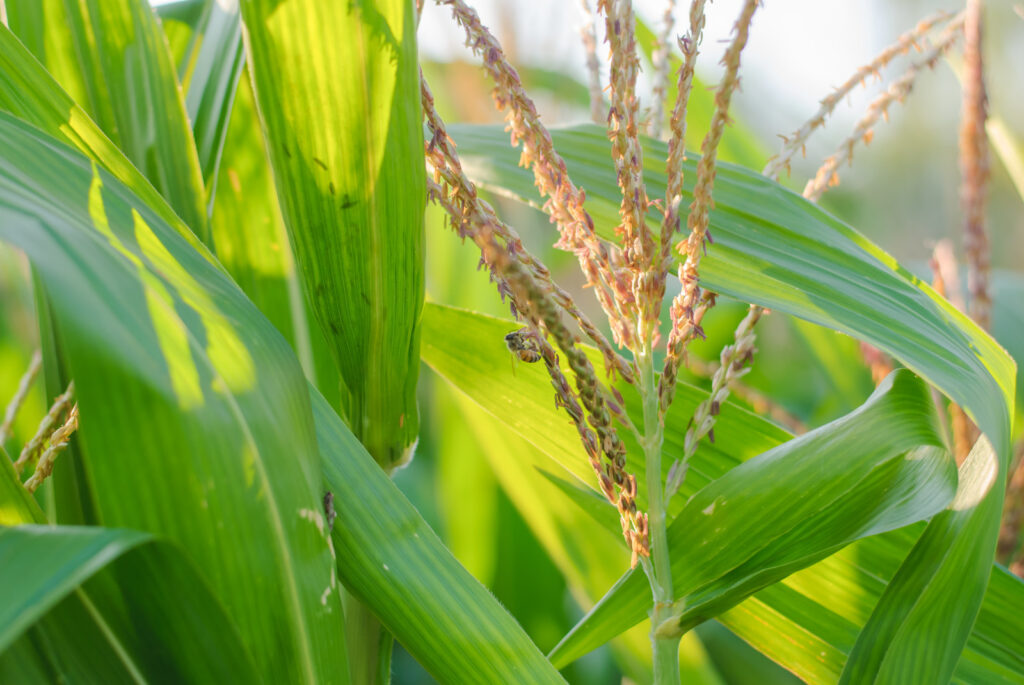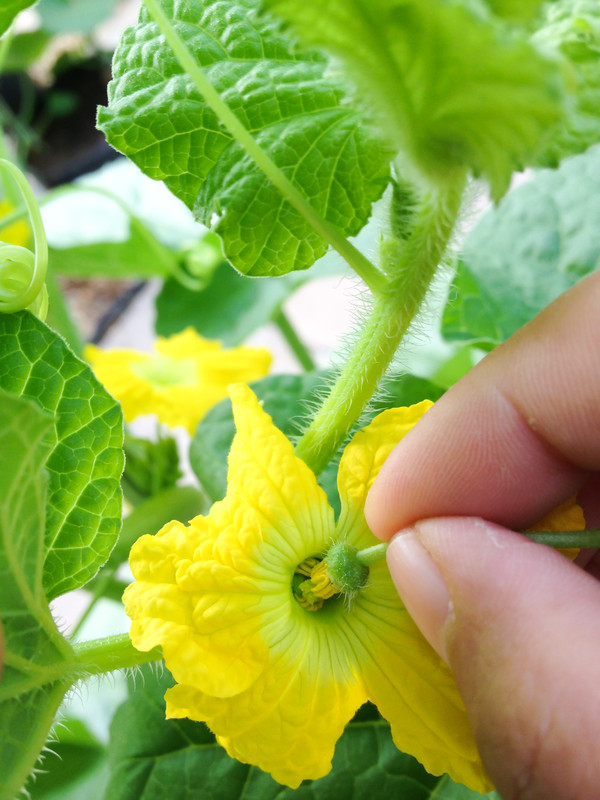Vegetables are pollinated in two ways: self-pollination and cross-pollination.
Self-pollinators are plants that produce flowers that are usually fertilized by their own pollen, commonly when the male and female flower parts are contained within the same flower.
Cross pollinators are plants with flowers that require pollen from another flower (a male flower on the same plant–thus a form of self-pollination–or from another plant) to produce a fertilized seed. Cross-pollinators commonly require the help of insects or the wind to achieve pollination.

Vegetables and how they are pollinated
Self-pollinated vegetables include bush and pole beans, lima beans, chicory, endive, lettuce, English and Southern peas, and tomatoes.
Wind-pollinated vegetables include beets, chard, sweet corn, and spinach.
Insect-pollinated vegetables include asparagus, broccoli, Brussels sprouts, cabbage, carrots, cauliflower, celeriac, celery, Chinese cabbage, collards, cucumbers, eggplant, gourds, kale, kohlrabi, muskmelons, mustard, okra, onions, parsley, parsnip, hot pepper, pumpkin, radish, rutabaga, spinach, squashes, turnips, and watermelon.
Vegetable plant pollination basics
How a vegetable is pollinated is important if you want to grow plants that are true-to-type, meaning the same as the parent plant: for example, if you want the same fruit size, color, shape, and flavor, the same plant height or growing habit, the same days to maturity and harvest. If a vegetable is cross-pollinated by a plant that is not the same strain or variety, it will not grow true-to-type.
Self-pollinated vegetables usually grow true. There is minimal risk of cross-pollination because the pollen from the male part of the flower (called the anther) usually falls directly on the female part of the flower (called the stigma) with little room for error or cross-pollination.
Cross-pollinated vegetables often grow true-to-type but not always. Cross-pollinated crops may not grow true if the pollen from a different strain or variety of the same crop or different crop in the same family is introduced into the female flower. When this happens the results can be unpredictable and the offspring will not grow true to type; the new seed and plant will not be like its parents. To avoid cross-pollination of unlike varieties or crops, flowering plants must be separated or isolated so that insect pollinators and the wind do not inadvertently cross-pollinate the plants.

Open-pollinated and hybrid vegetables
Often you will read or hear a discussion of open-pollinated and hybrid vegetables and other plants.
Open-pollinated plants
Plants that pollinate naturally–either by self-pollination or cross-pollination by wind or insects–are called open-pollinated. (The opposite of open pollination is controlled pollination–usually where the pollen comes from a different strain or variety or species by design and manipulation. Controlled pollination is plant breeding, commonly called hybrid pollination. Usually, hybrid pollination comes after parent plants are selected for desired traits.)
Open-pollination usually, but not always, produces offspring similar to the parents and true-to-type–offspring that share the same traits of their parents. But because open-pollination is not closely controlled, open-pollinated plants may naturally pick up characteristics that differ from their parents. This is called biodiversity.
Self-pollenizing plants usually breed true even when open-pollinated because the male and female parts are in the same flower or on the same plant. There is a decreased opportunity for pollen from unlike strains or varieties to reach the female flowers.
Cross-pollenizing plants will breed true when the pollen comes from the same plant or from the same strain or variety of plant. The challenge of growing cross-pollenizing plants by open pollination is preventing the pollen of, unlike strains, varieties, or species from pollinating the female part of the flower.
One way to ensure that cross-pollenizing plants do not breed untrue is to isolate cross-pollenizing plants at flowering time. Different strains, varieties, or species of cross-pollenizing plants can be isolated by distance (making it difficult for pollinating insects or the wind to transfer pollen) or enclosure–using insect-proof cages to prevent cross-pollination. Separation by distance in the home garden is difficult if not impossible; most cross-pollenizing plants need to be separated by ¼ of a mile or more to avoid cross-pollination by wind or insects.
A useful home garden strategy for avoiding cross-pollination of open-pollinated plants of differing strains, varieties, or species is to sow seed or set out transplants of differing plant strains or varieties in the same family (two different varieties of cabbage family plants, for example) at different times–usually two weeks or more apart–so that the plant’s flower at different times. That way insects or the wind can not achieve cross-pollination. Self-pollinated crops of different strains or varieties can be separated by both time and a few rows.
Biennials plants
Not all vegetables are pollinated in the same growing season they are planted. Biennial vegetable flower in their second year of life (provided they survive the winter in between). That means pollination of biennials occurs in the plant’s second year of life. Biennial vegetables include beets, Brussels sprouts, cabbage, carrots, celeriac, celery, chard, collards, Florence fennel, kale, kohlrabi, leeks, onions, parsley, parsnips, winter radishes, rutabaga, salsify, and turnips. Perennial vegetables also do not necessarily flower the same year that they begin growing.
Hybrid plants
Hybrid plants are the result of the deliberate cross-pollination of two selected lines of plants. Hybrids are commonly produced to make a seed that combines the best characteristics of the parents–productivity, uniformity, vigor, and pest resistance. Seeds collected from hybrids usually do not grow true to their hybrid parents; rather they often revert and display characteristics from more distant progenitors.
F1 hybrid seed. Many selectively bred vegetable varieties are F1 hybrids (Filial 1, the first filial generation). F1 hybrids are made by crossing two distinctively different parent lines or parent cultivars to produce an offspring that is different from the parental types but with specific desirable characteristics from either or both parents. F1 hybrids are created for exceptional vigor and improved growth, quality, uniformity, and yield. Seed from F1 hybrids will not breed true-to-type. F1 hybrids must be remade by controlled pollination every time seed is needed. (That is why F1 hybrids can be expensive.) This is a time-consuming and exacting breeding process not usually undertaken by home vegetable gardeners.

Self-pollinating pollination
Some vegetables are self-pollinating meaning they do not need the assistance of bees or other insects or the wind for pollination and the production of fruit.
Self-pollinating vegetables include tomatoes, green peppers, chili peppers, eggplants, green beans, lima beans, sweet peas, and peanuts.
Pollen is required for a flower to produce fruit. Self-pollinating vegetables have what is called “perfect” or “complete” flowers because each flower contains both the male (anther) and female (stigma) flowering parts necessary for fertilization and fruit production. Pollen must pass from the anther to the stigma for fertilization to occur. Some vegetables—squash plants for example–produce separate male and female flowers—those flowers are not complete or “perfect.”
If self-pollinating vegetables are not producing fruits, you can help them along. When a self-pollinating plant is flowering you can simply give it a gentle shake or shimmy to help the pollen drop. You can also use a soft cotton cloth to fan the flowers—again helping the pollen to drop from the anther to the stigma.

Hand pollination
Hand pollination is the manual transfer of pollen from the stamen of one plant to the pistil of another–that is from a male flower to a female flower.
Members of the Cucurbit family–squash, melons, pumpkins, and cucumbers–often have pollination problems because the male flowers commonly open days before the female flowers and so often drop before pollinators such as bees can transfer pollen from male to female flowers.
When female flowers are not pollinated, the fruit will never appear. The nascent fruits–bulging embryos–at the stem end of female flowers will shrivel and die if not pollinated.
If fruit is not forming on your Cucurbit family plants, you can help. Rub a small brush or cotton swab on the stamen of a male flower (it will be dusty with pollen) then rub the brush on the stigma of the female flower.

Alternatively, you can remove the petals from a male flower and brush the stamen against the stigma of a female flower.
Which flower is male and which is female? Female flowers have a small bulge (a small immature flower) where the stem meets the flower. Male flowers are shorter than female flowers and often appear in clusters.
Related articles:
Vegetable Garden Beneficial Insects
Garden Planning Books at Amazon:
- Vegetable Garden Almanac & Planner
- Kitchen Garden Grower’s Guide Vegetable Encyclopedia
- Vegetable Garden Grower’s Guide
- Tomato Grower’s Answer Book



